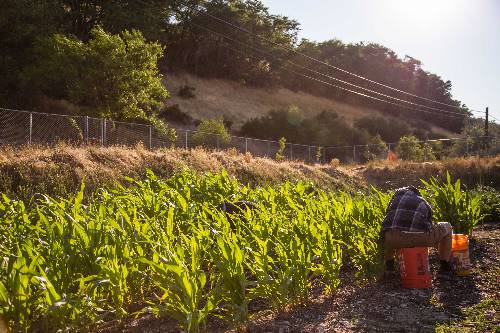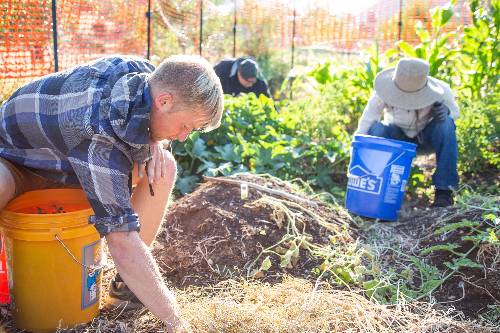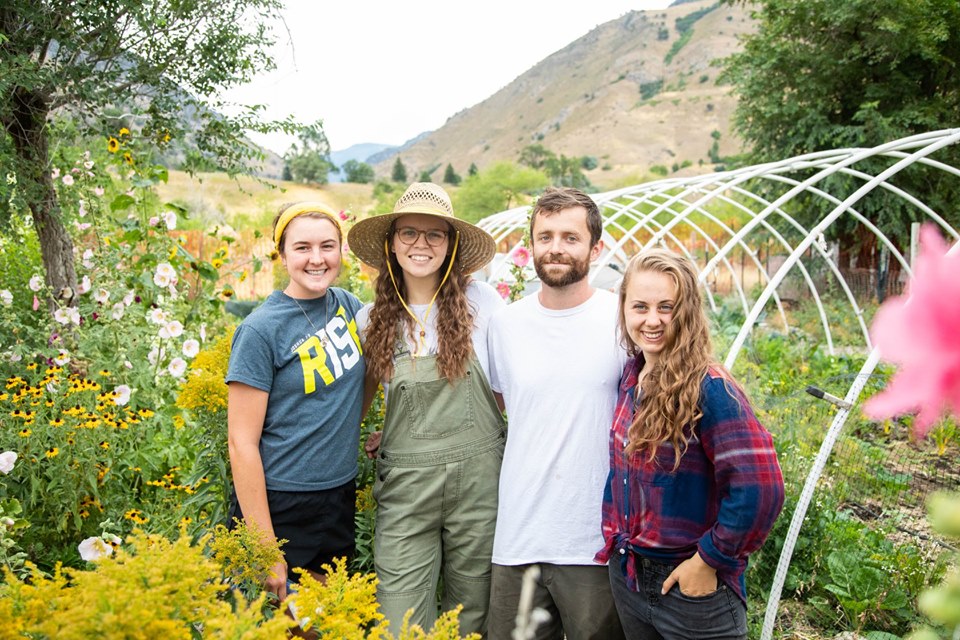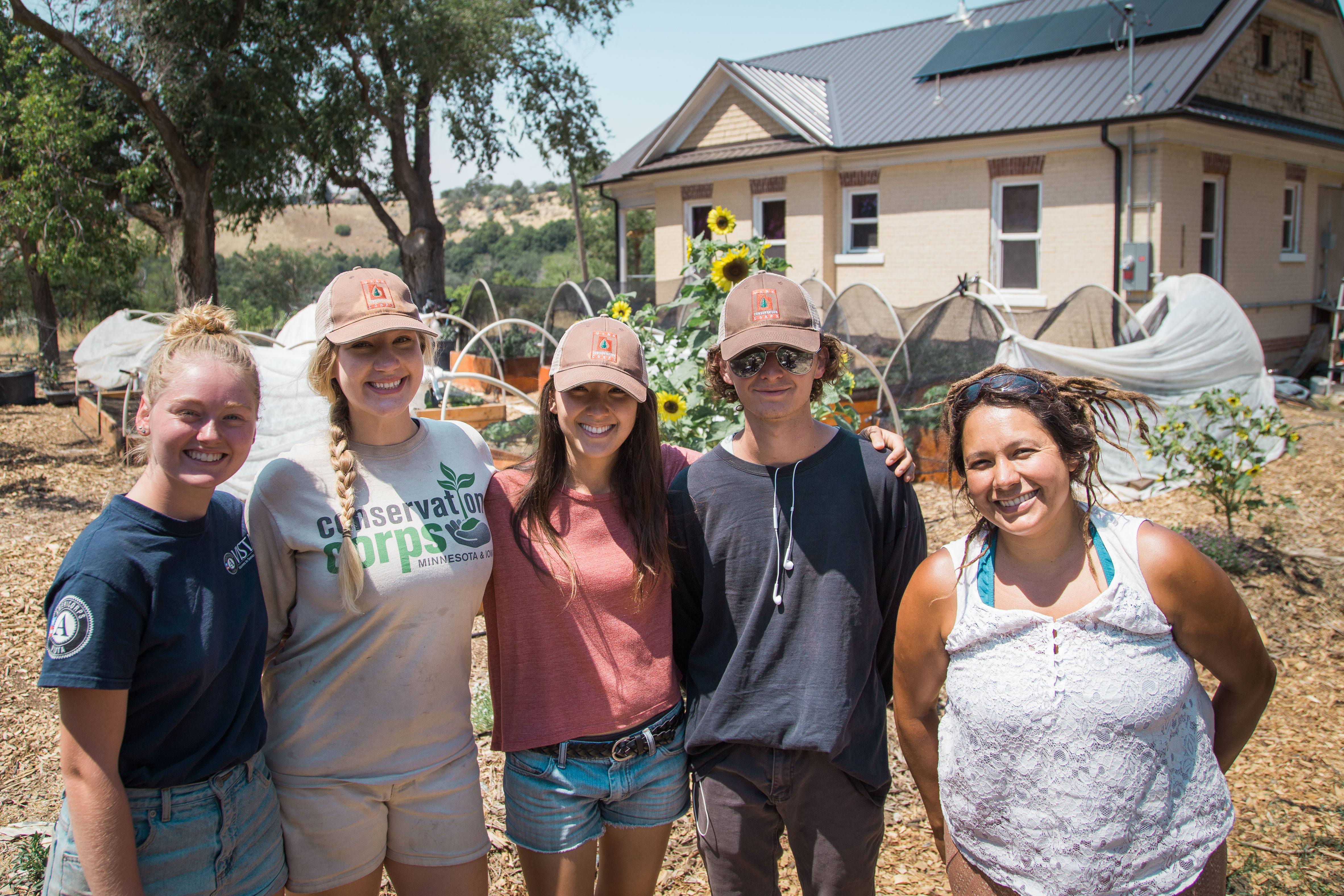Community Agriculture: Concepts, Models, and Impacts
Utah State University Department of Environment and Society and Utah Conservation Corps
Defining Community Agriculture
Community agriculture initiatives are often run by organizations (1) relying on volunteer structures; (2) growing produce sustainably; and (3) aiming to improve health and access to food in their communities.
To clarify “growing produce sustainably,” the Utah Conservation Corps Urban Community Farm (UCCUCF) (a volunteer and AmeriCorps-driven community agriculture model based in Logan, Utah) engages in the following regenerative agriculture practices:
- Using crop diversification and companion planting (allowing for increased pest control, building healthy soil, shade benefits, reducing available space for weeds, and more).
- Rotating crops (building healthy soil, reducing buildup of certain pest/disease populations, and replenishing soil nutrients).
- Planting cover crops (protecting soil and reducing erosion, and increasing organic matter and nutrient content of soil).
- Focusing on plant varieties that are suitable for our specific climate (using drought or low-water-tolerant plants adapted to local soil and climatic conditions to avoid fighting nature or putting more resources into growing healthy plants than necessary).
- Using native plant species where possible (especially pollinator-friendly plants like wildflowers to increase the presence of bees, birds, etc.).
- Watering on specific schedules, mainly via dripline (delivering irrigation directly to the roots and only where desired so minimal water is wasted, and watering during the coolest part of the day so minimal water is lost due to evaporation).
- Using organic pest/weed control where possible, and always implementing integrated pest management (releasing ladybugs to biologically control aphids, using oil traps to control earwigs, building a high-quality fence to keep deer out, using weed barrier fabric, etc.).
- Composting (turning garden waste, fallen leaves, food scraps and more into natural fertilizer that increases yield and crop health).
Community Agriculture vs. Community-Supported Agriculture
 Community agriculture is similar to community-supported agriculture (CSA) in that they both provide local food to their communities. Where they differ is in their approach. Community-supported agriculture models are structured in a way that community members pay an amount upfront that covers a weekly produce delivery for the entire season (McMurray et al., 2017). If some of the produce fails, the shareholders have already paid for the risks. Community agriculture works with local farmers, gardeners, and volunteers to donate produce. Using the UCC UCF as an example, participants and volunteers are trained to grow produce with the intention of donating to communities struggling with food security.
Community agriculture is similar to community-supported agriculture (CSA) in that they both provide local food to their communities. Where they differ is in their approach. Community-supported agriculture models are structured in a way that community members pay an amount upfront that covers a weekly produce delivery for the entire season (McMurray et al., 2017). If some of the produce fails, the shareholders have already paid for the risks. Community agriculture works with local farmers, gardeners, and volunteers to donate produce. Using the UCC UCF as an example, participants and volunteers are trained to grow produce with the intention of donating to communities struggling with food security.
Community Agriculture Growth During Times of Hardship
During the major world wars, millions of Americans transitioned front and backyards, disused space at schools, and vacant lots into “victory” gardens to help with the war efforts. During this period, it is estimated from promotional materials that 15 million victory gardens produced 7.5 billion pounds of food and provided 40% of the nation’s vegetable needs (Lawson, 2005).
Similar to past times of hardship, the COVID-19 pandemic’s disruption of the food supply chain, increas in the physical and economic barriers that restrict access to food, and catastrophic rise in food waste because of labor shortages have brought to the forefront the need to increase food security through local production in and around urban centers (Lal, 2020). Home gardening and urban community agriculture models (occurring at a micro and household scale) are one way to help reduce our dependence on imported fruits and vegetables, thus increasing food security (Tagtow & Richey, 2012). As suggested by Lal (2020), home and community gardening “can play an important role in advancing food and nutritional security during and after the COVID-19 pandemic, while also strengthening the provisioning of numerous ecosystem services (i.e., plant biodiversity, microclimate, water runoff, water quality, human health)” (p.871). This is especially important in Utah, as we import 98% of our fresh vegetables and 96% of our fresh fruit (Teichert, 2018; Envision Utah, n.d.).
Urban agriculture is producing almost 20% of the world’s food supply and can play an even more critical role in achieving food security during a global crisis such as that created by COVID-19 (Lal, 2020). Although local food production is seeing a resurgence under pandemic conditions, many planners do not incorporate community agriculture into urban planning as they lack the connections and knowledge to implement these programs (Mendes et al., 2008). As a result, calls for support by community agriculture advocates to local government and even community development corporations are often neglected (Campbell, 2004). In an effort to help overcome the barriers to increasing food production, this publication uses the UCC UCF as a model for community agriculture.
Included within are:
- Benefits and challenges of community agriculture.
- Logan, Utah’s UCC UCF as a replicable model of
community agriculture. - Additional successful community agriculture models.
- A glossary of terms.
Community Agriculture Benefits
“The people who use neighborhood gardens vary as much as the plants that are grown in them.”
-Laura Lawson
Health
Community agriculture can increase access to healthy foods like fruits and vegetables, especially in low-income areas with limited access otherwise. It also provides opportunities for public health programming to improve nutritional knowledge and attitudes (Hodgson et al., 2011). Community agriculture aims to increase civic participation in personal food production, while improving both diets and food security. Individuals and households who participate in such programs are over three times more likely to consume fruits and vegetables at least five times a day than people without a gardening household member (Alaimo et al., 2008), leading to improved diets and healthier lifestyles.
In a thematic review, Dyg, Christensen, and Peterson (2020) found that community garden participation is positively associated with reducing body weight and hypertension, and increasing physical activity and knowledge. On a psychological level, gardens offer minorities a place to connect to their cultural heritage by providing an area to express their ethnic identity and grow specialty food items not available elsewhere. This can lead to an enhanced sense of well-being (Milburn & Vail, 2010).
Social
 Community agriculture provides many social benefits, including opportunities for community engagement, fostering interactions between diverse communities, as well as health and environmental stewardship education (Dyg et al., 2020; Lawson, 2005). Building connections between growers and consumers can also play an important role in supporting economic security. Because the community gardens within community agriculture models offer many benefits and consider barriers to food access, they provide a venue to link the concerns of urban planners, farmers, food banks, community development corporations, social service agencies, and environmentalists (Lawson, 2005). In addition, community gardens positively influence selfesteem, independence, and personal control, particularly for refugees (Dyg et al., 2020).
Community agriculture provides many social benefits, including opportunities for community engagement, fostering interactions between diverse communities, as well as health and environmental stewardship education (Dyg et al., 2020; Lawson, 2005). Building connections between growers and consumers can also play an important role in supporting economic security. Because the community gardens within community agriculture models offer many benefits and consider barriers to food access, they provide a venue to link the concerns of urban planners, farmers, food banks, community development corporations, social service agencies, and environmentalists (Lawson, 2005). In addition, community gardens positively influence selfesteem, independence, and personal control, particularly for refugees (Dyg et al., 2020).
Other social benefits include creating a safe community space and introducing new friendships that render a collective investment in the well-being of the neighborhood (Hodgson et al., 2011). In areas like New York, St. Louis, Seattle, or Los Angeles, neighborhood gardens demonstrate high cultural diversity of their participants. This can be attributed to immigration patterns that are reflected in the design and planting of community gardens (Lawson, 2005). These community programs also create pathways for local educators, university faculty, and local organizations to share knowledge with the community (Feenstra, 2002).
Economic
A key economic benefit is the reduction in grocery expenses when receiving harvest from community gardens; a conservative estimate is that a family can save approximately $475 a year (Patel 1991). Community agriculture can also increase property values, local employment opportunities, and income (Hodgson et al., 2011). These projects often train novice gardeners and lead to increased employment in food production, manufacturing, and distribution. Kobayashi, Tyson, and Abi-Nader (2010) estimate more than 35,000 farmers and gardeners have emerged from civic/community agriculture projects. On a larger scale, local governments could benefit from investing in community agriculture because the costs of maintenance and development are typically less than those of traditional city parks (Milburn & Vail, 2010).
Environmental
Community agriculture can help foster environmental connectedness, political consciousness, and activism among youth and adults (Spilkova, 2017). Additionally, it can decrease stormwater runoff and air pollution, and increase biodiversity and species habitat. This model is also a great use of vacant property to prevent harm to the area via crime or trash accumulation (Hodgson et al., 2011) and reintroduce green spaces and nature to urban areas (Lawson, 2005).
Community Agriculture Challenges
Common challenges experienced during planning and development include location (i.e., adequate sunlight), access to water (i.e., no competition with neighboring properties for water resources), and finding qualified/educated leadership that can handle unforeseen problems (Milburn & Vail, 2010). These programs vary from place to place and are difficult to replicate unless a model from a similar area exists. For example, California has a nearly year-round growing season where many other areas of the country do not. Other factors involved are climate change, local politics, land availability, and funding. The majority of these factors will differ in each locale (Lawson, 2005).
Risks
Community agriculture also presents potential health and environmental risks. Some factors to examine include the history of the locations (past uses) and proximity to other 3 industrial sites, automobile traffic, and other pollutants. Consider soil and water contaminants stemming from industrial wastes and pollutants, such as heavy metals, hydrocarbons, acids or bases, asbestos, solvents, or pathogenic organisms. Assessment of prior cleanup or containment of a site is extremely important as it can present serious health risks to both producers and consumers through contact with contaminated water and soil. These issues can also lead to the contaminants of foods that may also be a risk if consumed (Hodgson et al., 2011).
Inappropriately managed compost facilities, use of fertilizers and pesticides, and poor cultivation, harvesting, poultry, and animal-keeping practices can lead to noise and odor nuisances. Regulatory structures can help ensure that urban agriculture complements other land uses. Limited land tenure, access to water, and inadequate funding can also present significant challenges and risks to the success of community agriculture (Hodgson et al., 2011).
The Utah Conservation Corps Urban Community Farm (UCC UCF): A Community Agriculture Model
History and Mission
The UCC UCF is a nearly year-round, four-season, civic engagement and agriculture education project that started in 2017 in Logan, Utah. The UCC UCF aims to improve food security by increasing civic participation in crop production and by providing a range of education, training, and other resources to the local food-insecure population. Gardeners learn how to maintain efficient and productive small-scale agricultural systems, thereby strengthening individual self-reliance and access to fresh food items, which contributes to the overall strengthening of food security. All crop yields are donated to the local foodinsecure community.
The UCC UCF partners with Utah State University personnel to develop its program capacity resources (program tracking tools, education and training materials, outreach strategies), improve the project’s visibility within the community, and maximize community impact. This partnership helps the UCC UCF to publicly illustrate how small-scale seasonal production systems provide consistent crop yields year-round and fosters increased participation in civic agriculture.
The UCC UCF documented the following accomplishments in 2019:
- Harvested and donated 3,788 pounds of produce.
- Recruited and managed 310 community volunteers that served a total of 1,712 hours.
- Directly assisted five community organizations serving food-insecure community members through providing consistent produce, albeit a large majority of produce was donated to two partner entities: Student Nutrition Access Center and Cache Community Food Pantry.
Currently, the UCC UCF is staffed by the manager, two AmeriCorps Volunteers in Service to America (VISTAs), and four summer associate VISTA members. The UCC UCF manager is in charge of the daily operations and directly supervises volunteers. The two AmeriCorps VISTAs provide indirect service support, including volunteer recruitment and management as well as grant writing and resource development. Summer associate VISTA members complete direct service in the summer growing season. Crops are chosen based on past and anticipated user demand.
 Volunteers are heavily relied on for this program, so training and education is an important factor. UCC UCF participants are taught how to propagate plants using methods and techniques that conserve natural resources and that are replicable in household and small-scale farming systems. Other educational opportunities for youth and adults via weekly activities and bi-monthly seasonal workshops include cultivation, management propagation techniques, seasonal and environmental factors that influence propagation, plant health management, use and management of the extended season structures, and harvest techniques. The primary target audience is low-income, food-insecure individuals, and individuals inactive in urban agriculture.
Volunteers are heavily relied on for this program, so training and education is an important factor. UCC UCF participants are taught how to propagate plants using methods and techniques that conserve natural resources and that are replicable in household and small-scale farming systems. Other educational opportunities for youth and adults via weekly activities and bi-monthly seasonal workshops include cultivation, management propagation techniques, seasonal and environmental factors that influence propagation, plant health management, use and management of the extended season structures, and harvest techniques. The primary target audience is low-income, food-insecure individuals, and individuals inactive in urban agriculture.
- In 2017 and 2018, the UCC UCF provided engagement and education to 500 individuals, offering nearly 5,000
hours of engagement and training. - UCC UCF staff schedule a series of urban agriculture education classes offered to the low-income patrons of their community partners. They also offer education opportunities to 4-H and additional youth groups.
- Currently, youth groups receive an estimated 150 hours of annual urban agriculture training at the UCC UCF site.
The amount of produce UCC UCF grows and harvests is measured by weight. In future growing seasons, they plan also to evaluate impact through:
- Obtaining an accurate estimated dollar value of the food donated.
- Finding an average amount of money individuals and families might save by having access to UCC UCF produce.
- Keeping data on the amount of food donated (in lbs.) to each delivery site.
- Learning how much produce is distributed to families, how many families benefited, and how much the families feel access to the produce has improved their lives on a weekly/daily basis.
Additional Successful Community Agriculture Models
Alemany Farm (alemanyfarm.org/) is a 4.5-acre hybrid urban farm in southeastern San Francisco. Their main goals are fighting food insecurity, and providing environmental education by using different techniques including workshops, educational courses, a free neighborhood produce-delivery program, and field trips.
The Community Action Coalition of South-Central Wisconsin (cacscw.org/) is a nonprofit anti-poverty organization supporting many low-income families by growing food in more than 50 community gardens throughout the city. Their efforts have provided nearly 2,000 low-income households with access to fresh fruits and vegetables, reducing their grocery bills.
 DeLaney Community Farm (dug.org/about-delaneycommunity-farm/) is a project of Denver Urban Gardens located in Aurora, Colorado, and was created to increase access to fresh fruits and vegetables while also providing opportunities for nutrition education in low-income areas. Courses offered focus on all aspects of food production and consumption, such as growing, preparing, cooking, tasting, and sharing.
DeLaney Community Farm (dug.org/about-delaneycommunity-farm/) is a project of Denver Urban Gardens located in Aurora, Colorado, and was created to increase access to fresh fruits and vegetables while also providing opportunities for nutrition education in low-income areas. Courses offered focus on all aspects of food production and consumption, such as growing, preparing, cooking, tasting, and sharing.
The Resource Center (cityfarmchicago.org/) is a nonprofit organization in Chicago that operates a City Farm and has an agreement with the city to use vacant, publicly owned land, with the understanding that it may need to relocate every couple of years. The City Farm has had to relocate four times in the past 25 years but has been exceptionally successful regardless.
 The P-Patch Community Gardening Program (seattle.gov/neighborhoods/programs-and-services/p-patchcommunity-gardening) is located in Seattle, Washington. This program is managed by Seattle’s Department of Neighborhoods and now has about 90 community gardens. They partner with many organizations, which contributes to the great success of the program. One of their main goals is providing produce for low-income populations through their Market Garden Program. It encourages low-income families to grow and sell produce to improve their situations.
The P-Patch Community Gardening Program (seattle.gov/neighborhoods/programs-and-services/p-patchcommunity-gardening) is located in Seattle, Washington. This program is managed by Seattle’s Department of Neighborhoods and now has about 90 community gardens. They partner with many organizations, which contributes to the great success of the program. One of their main goals is providing produce for low-income populations through their Market Garden Program. It encourages low-income families to grow and sell produce to improve their situations.
All photos by Elizabeth Sodja, Gateway & Natural Amenity Region (GNAR) Initiative Coordinator
Glossary
AmeriCorps: A network of national service programs working to improve lives and foster civic engagement.
Community agriculture: Often run by organizations who are growing produce sustainably with the goal to improve health and access to food in their communities, especially among underrepresented populations.
Community-supported agriculture (CSA): Provides a direct connection between local community members and growers, generally through purchasing a weekly “share” of locally grown goods (McMurray et al., 2017).
Local food: Often sold directly from growers to consumers through farmers markets, roadside stands, and CSAs (Hand et al., 2018).
Regenerative agriculture: Farming and grazing practices that, among other benefits, mitigate climate change by rebuilding soil organic matter and restoring degraded soil biodiversity, resulting in both carbon drawdown and water cycle improvements (Regeneration International, 2019).
Urban agriculture: Can include community and private gardens, edible landscaping, fruit trees, food-producing green roofs, aquaculture, farmers markets, small-scale farming, hobby beekeeping, and food composting (Mendes et al., 2008).
References
- Alaimo, K., Packnett, E., Miles, R. A., & Kruger, D. J. (2008). Fruit and vegetable intake among urban community gardeners. Journal of Nutrition Education and Behavior, 40(2), 94–101. doi:10.1016/j.jneb.2006.12.003
- Campbell, M. C. (2004). Building a common table: The role of planning in community food systems. Journal of Planning Education and Research, 23(4), 341–355. doi:10.1177/0739456x04264916
- Dyg, P., Christensen, S., & Peterson, C. (2020). Community gardens and wellbeing amongst vulnerable populations: A thematic review. Health Promotion International, 35(4), 790–803.
- Envision Utah. (n.d.) Agriculture in Utah. EnvisonUtah. org. https://yourutahyourfuture.org/topic/agriculture/item/27-background-agriculture-in-utah
- Feenstra, G. (2002). Creating space for sustainable food systems: Lessons from the field. Agriculture and Human Values 19: 99–106. Kluwer Academic Publishers.
- Hand, P., Bartlett, B., & Weaver, B. (2018, December 07). What is “local” food? Retrieved September 13, 2020, from https://www.usda.gov/media/blog/2010/07/16/whatlocal-food
- Hodgson, K., Campbell, M. C., & Bailkey, M. (2011). Urban agriculture: Growing healthy, sustainable places. American Planning Association.
- Kobayashi, M., Tyson, L., & Abi-Nader, J. (2010). The activities and impacts of community food projects 2005–2009, 1–28. USDA/NIFA.
- Lal, R. (2020). Home gardening and urban agriculture for advancing food and nutritional security in response to the COVID-19 pandemic. Food Security, 12, 871–876.
- Lawson, L. J. (2005). City bountiful: A century of community gardening in America. University of California Press.
- McMurray, K. Hall, K. & Brain, R. (2017). Community supported agriculture: Definition, benefits, barriers, and resources for growers [Fact sheet]. Utah State University Extension. https://digitalcommons.usu.edu/cgi/viewcontent.cgi?article=2778&context=extension_curall
- Mendes, W., Balmer, K., Kaethler, T., & Rhoads, A. (2008). Using land inventories to plan for urban agriculture: Experiences from Portland and Vancouver. Journal of the American Planning Association, 74(4), 435–449. doi:10.1080/01944360802354923
- Milburn, L. S., & Vail, B. A. (2010). Sowing the seeds of success: Cultivating a future for community gardens. Landscape Journal, 29(1), 71–89. doi:10.3368/lj.29.1.71
- Patel, I. (1991). Gardening’s socioeconomic impacts. Journal of Extension, 29(4). https://www.joe.org/joe/1991winter/a1.php
- Regeneration International. (2019, May 29). Why regenerative agriculture? https://regenerationinternational.org/whyregenerative-agriculture/
- Spilkova, J. (2017). Producing space, cultivating community: The story of Prague’s new community gardens. Agriculture and Human Values, 34, 887–897. doi:10.1007/s10460-017-9782-z
- Tagtow, A. & Richey E. (2012, September). Growing solutions: Cultivating health and food security through food gardening in Iowa. Iowa Food Systems Council, Food Access & Health Work Group. www. IowaFoodSystemsCouncil.org/foodaccesshealth/
- Teichert, B. (2018, February 13). Utah working to improve specialty crop production. Utah Public Radio. https://www. upr.org/post/utah-working-improve-specialty-cropproduction
Authors
By: Bayli Hanson, Roslynn Brain McCann, and Sean Damitz


